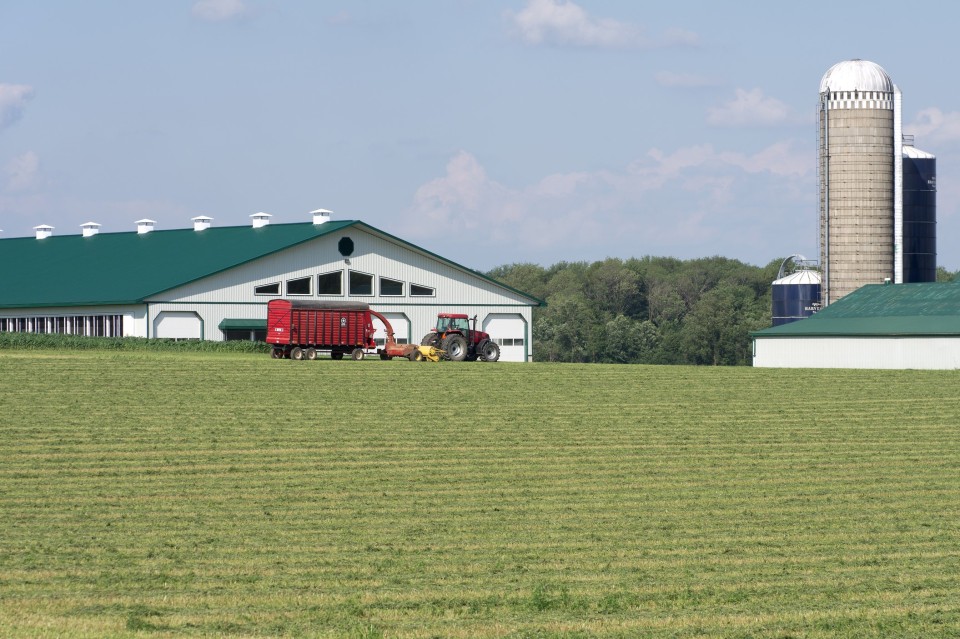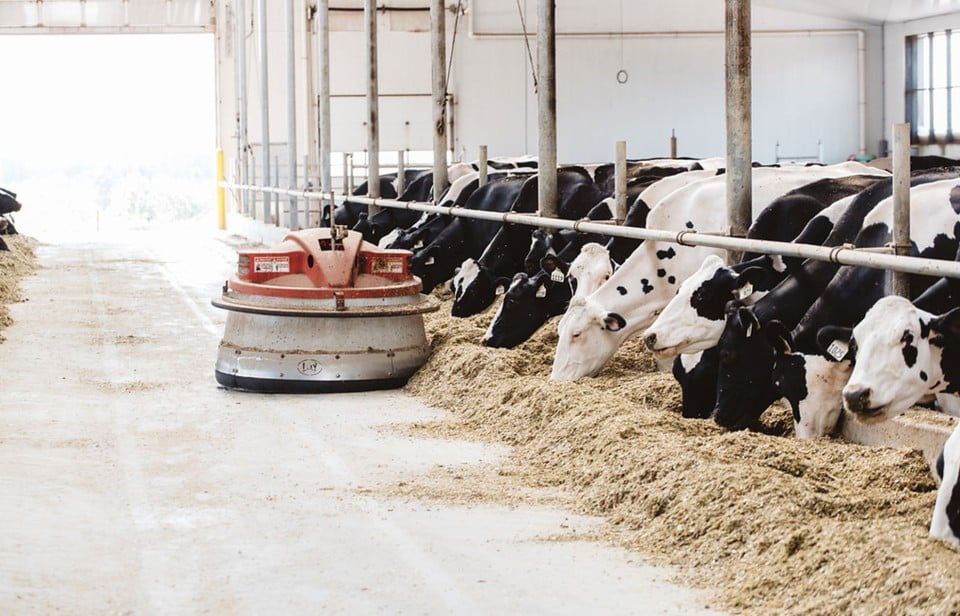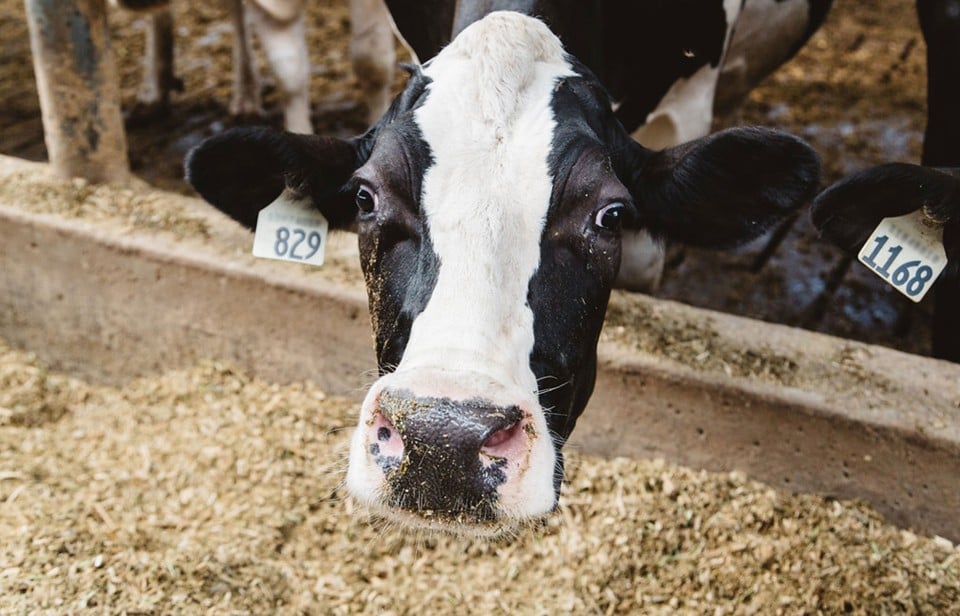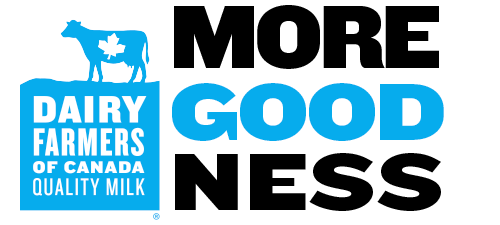Highlights
- The most common food for cows is grass
- A typical mature cow will eat approximately 29 kg of feed every day
- Canadian dairy farmers work closely with cow nutrition experts to finetune diets for their cows
It’s been said that you are what you eat (there’s a small chance you pictured yourself as a sentient bowl of mac and cheese for a second—and if you didn’t before, you did now). The point is that we recognize the importance of consuming quality food. To provide us with pure, nutritious milk, our cows are fed a research-backed diet that works best to meet their nutritional needs at each stage of life 1, 2. Healthy cows produce more (and better quality) milk!
What do cows eat
Dairy cows’ diets may vary according to the crops a farmer plants, which in turn depend on climate, soil type, and other considerations. In Canada, the most common food for cows is grasses (grass, alfalfa, corn stalk and leaves), which are served up in two different ways: dry hay and (moist) silage. Canadian dairy cows might also get important nutrients from crops such as corn, barley, clover, alfalfa hay, oats, and soybeans. Cows, because they are ruminants, also have the cool capacity to get nutrition from stuff that would otherwise be food waste, like soybeans that do not make the ‘human grade’ cut, or ‘grain meals’ such as crushed barley left-over from making beer!
Did you know that cows eat the entire plant? Not just the grains or flowers, but the leaves and stalks too.

To top that off, dairy farmers work closely with a cow nutrition expert. To ensure that our ‘dairy queens’ are receiving proper nutrition, cow feed is routinely tested. Their diets are determined based on their requirements for energy, fibre, carbohydrates, proteins and fat. The cow nutrition experts test the nutritious value of the crops grown on the farm at the time the farmer opens a silo. The nutrition expert then uses that analysis to help formulate diets that work best for specific groups of cows. For example, dietary needs will vary depending on the time of the year and their stage of lactation. This includes choosing the right vitamin, mineral or other types of supplements to ensure all cows enjoy a well-balanced diet that supports their needs.
Additionally, our farmers manage feed distribution, so all cows get the nutrition they need, and cows with specific needs receive special attention. All of this helps keep our cows well-fed and healthy.
In one day, a typical mature Holstein cow will eat approximately 29 kg of feed and wash that down with 80 to 180 litres of water (this volume depends on many factors, including her size and temperature that day). She’ll spend several hours relaxing and ruminating – in other words chewing the food that’s returned to her mouth from her stomach for a second chewing. To each their own!
Cows eat grass… and other plants
Most Canadian dairy farmers feed their cows a combination of grass and other plants, including grains, as mentioned above. However, there’s been growing consumer interest in grass-fed dairy for a variety of reasons, including its slightly higher omega-3 content. But what is grass-fed dairy?
It’s a bit of a misnomer, since it is the cows that are predominantly grass-fed, not the dairy products!
A first temporary standard was proposed in Ontario to define what it means for a cow to be considered “grass-fed”. Then Dairy Farmers of Canada has helped develop guidelines for a unified national standard 3. To meet the standard, 75% of its feed must consist of forage (any herbaceous plants that can be grazed or harvested, including grass, legumes, brassicas, and cereal grain crops in the vegetative state).
On organic dairy farms, cows must only eat organically grown crops 4.
Whether cows produce conventional, grass-fed, or organic milk, animal health and wellness come first on any Canadian dairy farm. Nutritional balance is a must, as are proper farm management practices. At Dairy Farmers of Canada, we believe in looking at dairy farming holistically, and we continue to invest in scientific research that helps us continue to better understand the dietary needs of cows, in the various climate of Canada. Together, Canadian dairy farmers, cow nutrition experts, and vets are keeping a close eye on our dairy superstars, so we can enjoy the natural goodness of Canadian milk.
Sources
- US National Academies of Sciences, Engineering, and Medicine. 2021. Nutrient Requirements of Dairy Cattle. nationalacademies.org/our-work/nutrient-requirements-of-dairy-cattle-8th-edition
- Ontario Veterinary College. Dairy Cattle Nutrient Requirements. ovc.uoguelph.ca/ruminant_health_management/dairy-cattle-nutrient-requirements
- Dairy Farmers of Canada. 2019. National Standard for the production of milk from grass-fed cows. dairyfarmersofcanada.ca/en/dairy-in-canada/dfc-national-standard-production-milk-grass-fed-cows
- Organic Council of Ontario. 2018. Organic: More than just grassfed. organiccouncil.ca/more-than-just-grassfed/
- Haspel, Tamar. 2015. Is grass-fed beef really better for you, the animal, and the planet? washingtonpost.com/lifestyle/food/is-grass-fed-beef-really-better-for-you-the-animal-and-the-planet/2015/02/23/92733524-b6d1-11e4-9423-f3d0a1ec335c_story.html








